Texas Hold’em Hands Ranked by Winning Percentage
The following chart contains every 2-card possible combination you can be dealt in Texas Hold’em. The hands are arranged by largest hole card with a separate section for pocket pairs.
Each hand will be followed by its long-term winning percentage (out of 100) against a specific number of opponents holding random cards. I believe that is the most logical way to rank overall poker hand strength.
It may be obvious, but look at how every starting hand wins less against more opponents. Statistics are telling you why you need to isolate with premium hands.
Table of Contents
- Every Texas Hold’em Poker Hand by Winning Percentage
- Average Winning Percentage (out of 100) with Pairs
- Winning Percentage with Ace-x
- Winning Percentage with King-x
- Winning Percentage with Q-x
- Winning Percentage with J-x
- Winning Percentage with 10-x
- Winning Percentage with 9-x
- Winning Percentage with 8-x
- Winning Percentage with 7-x
- Winning Percentage with 6-x
- Winning Percentage with 5-x
- Winning Percentage with 4-x
- Winning Percentage with 3-x
- Printable PDF of all my hand rankings
- Poker Hand Strength Chart
- Texas Hold’em Hand Selection
- Why random cards?
- How I calculated these hand strength numbers
- Using and Memorizing Starting Hand Charts
- Texas Hold’em starting hands best to worst
- Why is poker hand strength important?
- How many starting hands are there in Texas Hold’em?
- What are good Texas Hold’em hands?
- What to take away from hand strength rankings
- Poker hand strength fundamentals
- Beyond Starting Hands
- More Resources
Every Texas Hold’em Poker Hand by Winning Percentage
These charts show the average winning percentage (its equity) of every Hold’em hand at showdown. To find a specific hand’s ranking, look it up by its largest card. Unless noted, unpaired cards are unsuited. Suited cards add an average winning percentage of 3-4%.
Average Winning Percentage (out of 100) with Pairs
|
CARDS |
# of Opponents |
|||||||
|---|---|---|---|---|---|---|---|---|
|
1 |
2 |
3 |
4 |
5 |
6 |
7 |
8 |
|
|
AA |
85 |
73 |
64 |
56 |
49 |
43 |
39 |
35 |
|
KK |
82 |
69 |
58 |
50 |
43 |
38 |
33 |
29 |
|
|
80 |
65 |
54 |
45 |
38 |
33 |
28 |
25 |
|
JJ |
78 |
61 |
49 |
40 |
34 |
29 |
25 |
22 |
|
1010 |
75 |
58 |
45 |
36 |
30 |
25 |
22 |
19 |
|
99 |
72 |
54 |
41 |
33 |
26 |
22 |
19 |
17 |
|
88 |
69 |
50 |
38 |
29 |
24 |
20 |
18 |
16 |
|
77 |
66 |
46 |
34 |
26 |
21 |
19 |
16 |
15 |
|
66 |
63 |
43 |
32 |
25 |
20 |
17 |
15 |
14 |
|
55 |
60 |
40 |
29 |
22 |
19 |
16 |
14 |
13 |
|
44 |
57 |
37 |
25 |
21 |
17 |
15 |
14 |
13 |
|
33 |
54 |
34 |
24 |
19 |
16 |
15 |
14 |
13 |
|
22 |
50 |
31 |
22 |
18 |
16 |
14 |
13 |
13 |
Winning Percentage with Ace-x
| CARDS | # of Opponents | |||||||
|---|---|---|---|---|---|---|---|---|
| 1 | 2 | 3 | 4 | 5 | 6 | 7 | 8 | |
| AK (suited) | 67 | 51 | 41 | 35 | 31 | 28 | 25 | 23 |
| AK | 65 | 48 | 39 | 32 | 28 | 24 | 22 | 19 |
| AQ | 64 | 47 | 37 | 30 | 26 | 23 | 20 | 18 |
| AJ | 64 | 46 | 35 | 29 | 24 | 21 | 18 | 16 |
| A10 | 63 | 44 | 34 | 28 | 23 | 20 | 17 | 15 |
| A9 | 61 | 42 | 31 | 25 | 20 | 17 | 15 | 13 |
| A8 | 60 | 41 | 30 | 24 | 19 | 16 | 14 | 12 |
| A7 | 59 | 39 | 28 | 22 | 18 | 15 | 13 | 11 |
| A6 | 58 | 38 | 28 | 21 | 17 | 14 | 12 | 11 |
| A5 | 58 | 38 | 28 | 21 | 17 | 14 | 12 | 11 |
| A4 | 56 | 37 | 27 | 21 | 17 | 14 | 12 | 11 |
| A3 | 56 | 36 | 26 | 20 | 17 | 14 | 12 | 10 |
|
A2 |
55 |
35 |
25 |
20 |
16 |
14 |
12 |
10 |
Winning Percentage with King-x
| CARDS | # of Opponents | |||||||
|---|---|---|---|---|---|---|---|---|
| 1 | 2 | 3 | 4 | 5 | 6 | 7 | 8 | |
| KQ (suited) | 63 | 47 | 38 | 33 | 28 | 25 | 23 | 20 |
| KQ | 61 | 44 | 35 | 29 | 25 | 21 | 19 | 17 |
| KJ | 61 | 43 | 34 | 28 | 24 | 20 | 18 | 16 |
| K10 | 60 | 42 | 33 | 27 | 22 | 19 | 17 | 15 |
| K9 | 58 | 40 | 30 | 24 | 20 | 17 | 14 | 12 |
| K8 | 56 | 37 | 27 | 21 | 17 | 15 | 13 | 11 |
| K7 | 55 | 36 | 26 | 21 | 17 | 14 | 12 | 10 |
| K6 | 54 | 35 | 25 | 20 | 16 | 13 | 11 | 10 |
| K5 | 53 | 34 | 25 | 19 | 15 | 13 | 11 | 10 |
| K4 | 52 | 33 | 23 | 18 | 15 | 12 | 11 | 9 |
| K3 | 51 | 32 | 23 | 18 | 14 | 12 | 10 | 9 |
| K2 | 50 | 31 | 22 | 17 | 14 | 12 | 10 | 9 |
Winning Percentage with Q-x
| CARDS | # of Opponents | |||||||
|---|---|---|---|---|---|---|---|---|
| 1 | 2 | 3 | 4 | 5 | 6 | 7 | 8 | |
| QJ (suited) | 60 | 44 | 36 | 30 | 26 | 23 | 21 | 19 |
| QJ | 58 | 41 | 33 | 27 | 23 | 20 | 17 | 15 |
| Q10 | 57 | 40 | 31 | 26 | 22 | 19 | 16 | 14 |
| Q9 | 56 | 38 | 29 | 23 | 19 | 16 | 14 | 12 |
| Q8 | 54 | 35 | 26 | 21 | 17 | 14 | 12 | 11 |
| Q7 | 52 | 33 | 24 | 19 | 15 | 13 | 11 | 9 |
| Q6 | 51 | 32 | 23 | 18 | 14 | 12 | 10 | 9 |
| Q5 | 50 | 31 | 20 | 17 | 14 | 12 | 10 | 9 |
| Q4 | 49 | 30 | 21 | 16 | 13 | 11 | 9 | 8 |
|
Q3 |
48 |
29 |
21 |
16 |
13 |
11 |
9 |
8 |
|
Q2 |
47 |
28 |
20 |
15 |
12 |
10 |
9 |
8 |
Winning Percentage with J-x
| CARDS | # of Opponents | |||||||
|---|---|---|---|---|---|---|---|---|
| 1 | 2 | 3 | 4 | 5 | 6 | 7 | 8 | |
| J10 (suited) | 58 | 42 | 34 | 29 | 25 | 22 | 20 | 18 |
| J10 | 55 | 39 | 31 | 25 | 22 | 19 | 16 | 15 |
| J9 | 53 | 37 | 28 | 23 | 19 | 16 | 14 | 12 |
| J8 | 52 | 34 | 26 | 20 | 17 | 14 | 12 | 11 |
| J7 | 50 | 32 | 24 | 18 | 15 | 12 | 11 | 9 |
| J6 | 48 | 30 | 21 | 17 | 13 | 11 | 9 | 8 |
| J5 | 47 | 29 | 21 | 16 | 13 | 11 | 9 | 8 |
| J4 | 46 | 28 | 20 | 15 | 12 | 10 | 9 | 8 |
|
J3 |
45 |
27 |
19 |
15 |
12 |
10 |
8 |
7 |
|
J2 |
44 |
26 |
18 |
14 |
11 |
9 |
8 |
7 |
Winning Percentage with 10-x
| CARDS | # of Opponents | |||||||
|---|---|---|---|---|---|---|---|---|
| 1 | 2 | 3 | 4 | 5 | 6 | 7 | 8 | |
| T9 (suited) |
54 | 39 | 31 | 26 | 23 | 20 | 18 | 16 |
| T9 | 52 | 32 | 28 | 23 | 19 | 16 | 14 | 13 |
| T8 | 50 | 34 | 25 | 20 | 17 | 14 | 13 | 11 |
| T7 | 48 | 31 | 23 | 18 | 15 | 13 | 11 | 10 |
| T6 | 46 | 29 | 21 | 17 | 13 | 11 | 10 | 8 |
| T5 | 44 | 27 | 19 | 15 | 12 | 10 | 8 | 7 |
| T4 | 43 | 26 | 19 | 14 | 12 | 10 | 8 | 7 |
| T3 | 42 | 26 | 18 | 14 | 11 | 9 | 8 | 7 |
|
T2 |
42 |
25 |
17 |
13 |
11 |
9 |
8 |
7 |
Winning Percentage with 9-x
| CARDS | # of Opponents | |||||||
|---|---|---|---|---|---|---|---|---|
| 1 | 2 | 3 | 4 | 5 | 6 | 7 | 8 | |
| 98 (suited) | 51 | 36 | 29 | 24 | 20 | 18 | 16 | 15 |
| 98 | 48 | 33 | 25 | 20 | 17 | 14 | 12 | 11 |
| 97 | 47 | 31 | 23 | 18 | 16 | 13 | 11 | 10 |
| 96 | 45 | 29 | 21 | 17 | 14 | 11 | 10 | 9 |
| 95 | 43 | 27 | 19 | 15 | 12 | 10 | 9 | 7 |
| 94 | 41 | 25 | 17 | 13 | 11 | 9 | 7 | 6 |
| 93 | 40 | 24 | 17 | 13 | 10 | 8 | 7 | 6 |
|
92 |
39 |
23 |
16 |
12 |
10 |
8 |
7 |
6 |
Winning Percentage with 8-x
| CARDS | # of Opponents | |||||||
|---|---|---|---|---|---|---|---|---|
| 1 | 2 | 3 | 4 | 5 | 6 | 7 | 8 | |
| 87 (suited) | 48 | 34 | 27 | 22 | 19 | 17 | 15 | 14 |
| 87 | 46 | 31 | 23 | 19 | 15 | 13 | 12 | 10 |
| 86 | 44 | 29 | 21 | 17 | 14 | 12 | 10 | 9 |
| 85 | 42 | 27 | 19 | 15 | 12 | 11 | 9 | 8 |
| 84 | 40 | 24 | 18 | 13 | 11 | 9 | 8 | 7 |
| 83 | 38 | 22 | 16 | 12 | 10 | 8 | 7 | 6 |
| 82 | 37 | 22 | 15 | 11 | 9 | 8 | 6 | 6 |
Winning Percentage with 7-x
| CARDS | # of Opponents | |||||||
|---|---|---|---|---|---|---|---|---|
| 1 | 2 | 3 | 4 | 5 | 6 | 7 | 8 | |
| 76 (suited) | 46 | 32 | 25 | 21 | 18 | 16 | 14 | 13 |
| 76 | 43 | 29 | 22 | 17 | 14 | 12 | 11 | 10 |
| 75 | 41 | 27 | 20 | 16 | 13 | 11 | 10 | 9 |
| 74 | 38 | 25 | 18 | 14 | 11 | 10 | 9 | 8 |
| 73 | 37 | 22 | 16 | 12 | 10 | 8 | 7 | 6 |
| 72 | 35 | 20 | 14 | 11 | 9 | 7 | 6 | 5 |
Winning Percentage with 6-x
| CARDS | # of Opponents | |||||||
|---|---|---|---|---|---|---|---|---|
| 1 | 2 | 3 | 4 | 5 | 6 | 7 | 8 | |
| 65 (suited) | 43 | 30 | 24 | 20 | 17 | 15 | 14 | 13 |
| 65 | 40 | 27 | 20 | 16 | 13 | 12 | 10 | 9 |
| 64 | 38 | 25 | 18 | 14 | 12 | 10 | 9 | 8 |
| 63 | 36 | 23 | 16 | 13 | 11 | 9 | 8 | 7 |
| 62 | 34 | 21 | 15 | 11 | 9 | 8 | 7 | 6 |
Winning Percentage with 5-x
| CARDS | # of Opponents | |||||||
|---|---|---|---|---|---|---|---|---|
| 1 | 2 | 3 | 4 | 5 | 6 | 7 | 8 | |
| 54 (suited) | 41 | 29 | 23 | 19 | 17 | 15 | 14 | 13 |
| 54 | 38 | 25 | 19 | 15 | 13 | 11 | 10 | 9 |
| 53 | 36 | 23 | 17 | 14 | 11 | 10 | 9 | 8 |
| 52 | 34 | 21 | 15 | 12 | 10 | 9 | 8 | 7 |
Winning Percentage with 4-x
| CARDS | # of Opponents | |||||||
|---|---|---|---|---|---|---|---|---|
| 1 | 2 | 3 | 4 | 5 | 6 | 7 | 8 | |
| 43 (suited) | 38 | 26 | 20 | 17 | 15 | 13 | 12 | 11 |
| 43 | 34 | 22 | 16 | 13 | 11 | 9 | 8 | 8 |
| 42 | 33 | 21 | 15 | 12 | 10 | 8 | 7 | 7 |
Winning Percentage with 3-x
| CARDS | # of Opponents | |||||||
|---|---|---|---|---|---|---|---|---|
| 1 | 2 | 3 | 4 | 5 | 6 | 7 | 8 | |
| 32 (suited) | 35 | 24 | 18 | 15 | 13 | 12 | 11 | 10 |
| 32 | 31 | 20 | 14 | 11 | 9 | 8 | 7 | 6 |
Printable PDF of all my hand rankings
This is an 8.5 x 11-inch PDF of every Hold’em hand strength chart I’ve calculated. I’ve also formatted it as a color-coded “heat map” so you can easily see which class any given hand is in by its cell color.
It is sized to print perfectly on one sheet of paper, making it handy to live in front of your monitor and serve as a non-verbal guilt-maker for playing offsuit cards like 4♣-3♥ with a black rating.
Click the image below to view/download the PDF.
Poker Hand Strength Chart
| Ranking | Starting hand | # of opponents | ||
|---|---|---|---|---|
| 1 | 2 | 3 | ||
| Winning Percentage at Showdown | ||||
| 1 | A-A | 85 | 73 | 64 |
| 2 | K-K | 82 | 69 | 58 |
| 3 | Q-Q | 80 | 65 | 54 |
| 4 | J-J | 78 | 61 | 49 |
| 5 | 10-10 | 75 | 58 | 45 |
| 6 | 9-9 | 72 | 54 | 41 |
| 7 | 8-8 | 69 | 50 | 38 |
| 8 | 7-7 | 66 | 46 | 34 |
| 9 | A-K | 65 | 48 | 39 |
| 10 | A-Q | 64 | 47 | 37 |
| 11 | A-J | 64 | 46 | 35 |
| 12 | 6-6 | 63 | 43 | 32 |
| 13 | A-10 | 63 | 44 | 34 |
| 14 | A-9 | 61 | 42 | 31 |
| 15 | K-Q | 61 | 44 | 35 |
| 16 | K-J | 61 | 43 | 34 |
| 17 | 5-5 | 60 | 40 | 29 |
| 18 | A-8 | 60 | 41 | 30 |
| 19 | K-10 | 60 | 42 | 33 |
| 20 | A-7 | 59 | 39 | 28 |
| 21 | A-6 | 58 | 38 | 28 |
| 22 | A-5 | 58 | 38 | 28 |
| 23 | K-9 | 58 | 40 | 30 |
| 24 | Q-J | 58 | 41 | 33 |
| 25 | 4-4 | 57 | 37 | 25 |
| 26 | Q-10 | 57 | 40 | 31 |
| 27 | A-4 | 56 | 37 | 27 |
| 28 | A-3 | 56 | 36 | 26 |
| 29 | K-8 | 56 | 37 | 27 |
| 30 | Q-9 | 56 | 38 | 29 |
| 31 | A-2 | 55 | 35 | 25 |
| 32 | K-7 | 55 | 36 | 26 |
| 33 | J-10 | 55 | 39 | 31 |
| 34 | 3-3 | 54 | 34 | 24 |
| 35 | K-6 | 54 | 35 | 25 |
| 36 | Q-8 | 54 | 35 | 26 |
| 37 | K-5 | 53 | 34 | 25 |
| 38 | J-9 | 53 | 37 | 28 |
| 39 | K-4 | 52 | 33 | 23 |
| 40 | Q-7 | 52 | 33 | 24 |
| 41 | J-8 | 52 | 34 | 26 |
| 42 | 10-9 | 52 | 32 | 28 |
| 43 | K-3 | 51 | 32 | 23 |
| 44 | Q-6 | 51 | 32 | 23 |
| 45 | 2-2 | 50 | 31 | 22 |
| 46 | K-2 | 50 | 31 | 22 |
| 47 | Q-5 | 50 | 31 | 20 |
| 48 | J-7 | 50 | 32 | 24 |
| 49 | 10-8 | 50 | 34 | 25 |
| 50 | Q-4 | 49 | 30 | 21 |
| 51 | Q-3 | 48 | 29 | 21 |
| 52 | J-6 | 48 | 30 | 21 |
| 53 | 10-7 | 48 | 31 | 23 |
| 54 | 9-8 | 48 | 33 | 25 |
| 55 | Q-2 | 47 | 28 | 20 |
| 56 | J-5 | 47 | 29 | 21 |
| 57 | 9-7 | 47 | 31 | 23 |
| 58 | J-4 | 46 | 28 | 20 |
| 59 | 10-6 | 46 | 29 | 21 |
| 60 | 8-7 | 46 | 31 | 23 |
| 61 | J-3 | 45 | 27 | 19 |
| 62 | 9-6 | 45 | 29 | 21 |
| 63 | J-2 | 44 | 26 | 18 |
| 64 | 10-5 | 44 | 27 | 19 |
| 65 | 8-6 | 44 | 29 | 21 |
| 66 | 10-4 | 43 | 26 | 19 |
| 67 | 9-5 | 43 | 27 | 19 |
| 68 | 7-6 | 43 | 29 | 22 |
| 69 | 10-3 | 42 | 26 | 18 |
| 70 | 10-2 | 42 | 25 | 17 |
| 71 | 8-5 | 42 | 27 | 19 |
| 72 | 9-4 | 41 | 25 | 17 |
| 73 | 7-5 | 41 | 27 | 20 |
| 74 | 9-3 | 40 | 24 | 17 |
| 75 | 8-4 | 40 | 24 | 18 |
| 76 | 6-5 | 40 | 27 | 20 |
| 77 | 9-2 | 39 | 23 | 16 |
| 78 | 8-3 | 38 | 22 | 16 |
| 79 | 7-4 | 38 | 25 | 18 |
| 80 | 6-4 | 38 | 25 | 18 |
| 81 | 5-4 | 38 | 25 | 19 |
| 82 | 8-2 | 37 | 22 | 15 |
| 83 | 7-3 | 37 | 22 | 16 |
| 84 | 6-3 | 36 | 23 | 16 |
| 85 | 5-3 | 36 | 23 | 17 |
| 86 | 7-2 | 35 | 20 | 14 |
| 87 | 6-2 | 34 | 21 | 15 |
| 88 | 5-2 | 34 | 21 | 15 |
| 89 | 4-3 | 34 | 22 | 16 |
| 90 | 4-2 | 33 | 21 | 15 |
| 91 | 3-2 | 31 | 20 | 14 |
Texas Hold’em Hand Selection

If you’ve ever played Texas Hold’em you already know how important starting hand selection is. I’ve found that lack of hand strength knowledge is the #1 reason that beginning poker players lose.
The problem is that most starting hand guidelines are all based on opinion and there certainly isn’t a shortage of those.
What if there was a way to rank Texas Hold’em hands simply by strength and winning percentage? What if you could take opinion out of the equation?
That’s what I developed in these charts and what you can use to make better decisions at the tables. Each one is based on simulations of at least 10 million hands.
These numbers tell you the exact long-term winning percentage of every hand in Hold’em against specific numbers of opponents holding random cards.
I believe that long-term average winning percentage is the perfect way to rank starting hands in Texas Hold’em. No arbitrary bias, no adjustable strategy; simply the raw metrics of the game.
Why random cards?

One interesting key you should keep in mind is the simulations I ran to get these numbers are based on opponents holding random cards.
Why random cards? Because that’s the only way to run a fair simulation without bias.
Here’s the deal:
You and I might realistically know that pocket Aces are almost never going to play to a showdown against 7-2 offsuit, but if you try to limit simulations to hands that are likely to meet you’ve introduced opinion to data.
If I’m just giving opinions I can make an opinion-based starting Hold’em hand chart and be done with it. That’s been done to death and I’m not terribly interested in repeating it.
These charts won’t tell you, “Play this hand and not this one,” but they’ll rank which hands win more than others statistically. You’ll learn why hands are as strong as they are.
That’s pretty powerful, right?
How I calculated these hand strength numbers
The incomparable PokerStove desktop application may look like a relic from the Windows 95 days, but it’s actually invaluable for running large-scale Texas Hold’em calculations. It still works on Windows 10 and it’s quite easy to use once your eyes recover from the last-millennium GUI.
I manually set each Hold’em hand to player 1 and run separate Monte Carlo calculations of at least 10 million hands for each one against 1-8 opponents.
The results look like this for each hand, which shows how often the hand won the simulation:
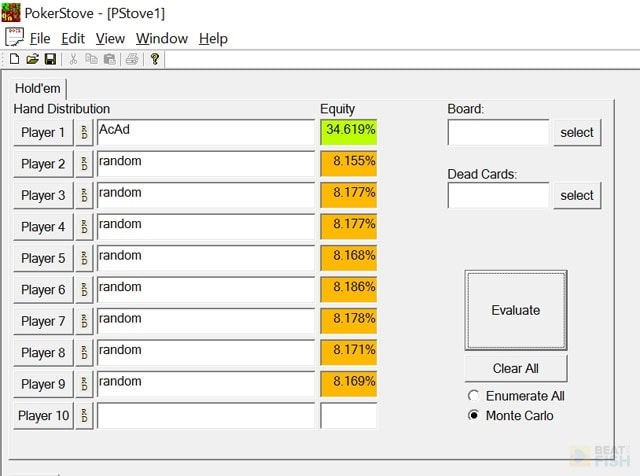
I then rounded each result to the nearest percentage point and put them into a table, which is what you see above and in the PDF.
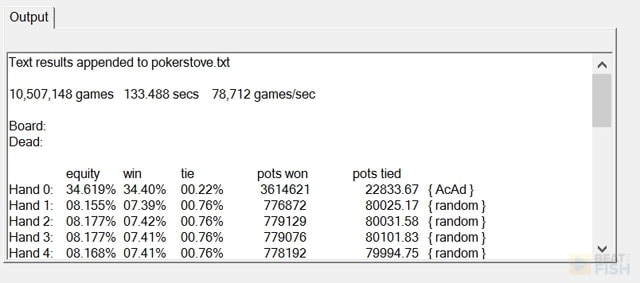
Using and Memorizing Starting Hand Charts
Since they provide a visual ranking of potential hole card combinations based on factors like pairs, suitedness, and card connectivity, these starting hand charts are invaluable tools for mastering hand strength. What
Memorization Techniques
Regular review is key. I would even consider printing out a chart for quick reference during play or try visualization techniques to internalize the hand rankings.
aiming to recognize potential for hands like straights or three-of-a-kind quickly.
Beyond the Chart: While charts offer a great base, they shouldn’t be the sole factor in your preflop decisions. Position and stack depth, discussed below, significantly impact how you play your hands.
Texas Hold’em starting hands best to worst

This chart will give you the rank of Texas Hold’em hands from best to worst.
This can serve as an easy list of all hands sorted by strength rather than separated by biggest starting card.
I am including all 13 pocket pairs and 78 unique non-paired starting hands for a total of 91 hands.
Those 78 hands could be counted a second time as suited starting hands win slightly more often, but I’m omitting suited cards to be more concise.
Keep in mind that these are not recommendations or rankings for playing starting hands in real-life cash game situations and tournaments. This is simply ranked raw data of which Texas Hold’em hands win most against random opponent cards.
Why is poker hand strength important?
Understanding poker hand strength is one of the first key concepts new players should learn and veterans should never forget.
Many a recreational poker player (often called simply recs these days) miss this basic building block of Texas Hold’em, playing starting hands based on hunches, tilt, intoxication level, or personal grudges. If you’re playing online without the aid of a HUD (as I always do), this concept becomes even more essential to keep in mind. Be better than that. I’ll help you with these Hold’em hand charts.
Knowing the relative strength of your starting hand impacts several crucial aspects of the game:
- Preflop Action: Strong hands like pocket Aces or a royal flush potential with suited connectors justify aggressive play like raises and re-raises to build the pot and extract value from weaker holdings.
- Postflop Decisions: A promising starting hand like trips or a good flush draw gives you more confidence to bet on later streets if the community cards align in your favor.
- Drawing Potential: Hands with good draw potential (like suited gappers aiming for a straight flush) might warrant staying in the pot if you believe the odds of improving are in your favor.
You cannot be a member of the Winning Texas Hold’em cluv without knowing the value of starting hands relative to each other
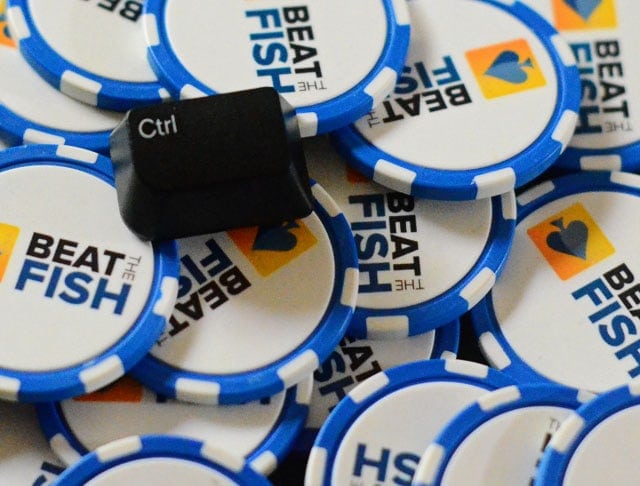
3 observations on Texas Hold’em hand strength
- Every hand in Hold’em wins less often when played against more players.
That sounds obvious, right?
Yet players routinely slowplay their top starting hands pre-flop like pocket Aces and Kings. By doing this you’re literally inviting your winning percentage to go down.
- Mediocre hands are all a jumble of mediocre winning percentages.
Some of the most common hands that many Hold’em players stick with like KQ, J-10, or Q-J all have similar middling winning percentages.
They all have similar unremarkable hand strength, meaning that unless you have position, lots of experience, or a good read you’re probably better off not playing them at all.
- Winning poker hands are more about how you play them than the numbers.
Take, for instance, the poker percentages of AK, one of the few extremely powerful hands in Texas Hold’em. Technically, it wins less than a middle pocket pair like 7-7.
Aside from all-in heads-up tournaments A-K is a much stronger hand in real-life scenarios because real-life hands aren’t random hands staying in to showdown. Big Slick would have (should have) eliminated those weaker random hands pre-flop.
Poker winning percentages aren’t everything
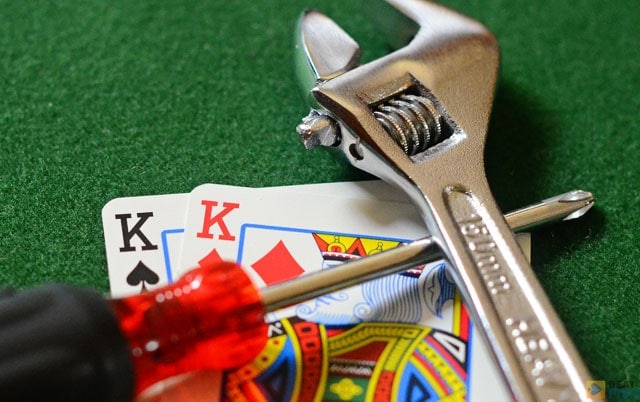
Average poker winning percentages, which is what hand strength is based on, certainly aren’t everything, but it’s half of the pre-flop puzzle.
If you can have a general set of starting hand guidelines (i.e. what you’ll play from what position) that are rooted in hand strength you can make more automatic pre-flop decisions.
That will free your mind up to actually start playing your opponents and the specific table situation. Once you’ve mastered starting hand discipline you can make deviations to your rules and play a wider range of hands.
Hold’em hand rankings reinforce essential concepts, even if you don’t pay careful attention to the numbers. Limit the number of opponents with your strongest hands and realize just how few starting hands are dominant by the numbers.
If only one thing sticks with you from these charts make it that even the best hands in Hold’em have pathetic value against several opponents. Still want to slowplay those Aces pre-flop?
How many starting hands are there in Texas Hold’em?
Strangely, the number of starting hands in Texas Hold’em is somewhat subjective and the answer depends on how broad you want define the results. The commonly accepted number is 169. Here are some key numbers on starting hands:
- There are 13 pocket pairs you can be dealt as starting hands: 2-2 through A-A.
- There are 78 unpaired hands that you can be dealt in Texas Hold’em, ignoring suit (e.g. A-2, K-10, 6-2).
- Those same hands make up another set of 78 when suited (e.g. 9♥-8♥, A♣-8♣, Q♦-J♦)
- The above 3 sets of hands add up to form the common answer of 169 Texas Hold’em starting hands
- There are actually 1,326 combinations of starting hands if you count suits (e.g. A♣-A♦ and A♠-A♥ are different hands), but that is more of a “just for fun” number as suits have no value over each other in Texas Hold’em.
- As suited cards slightly increase the value of a starting hand due to their higher flush capabilities (you can see this illustrated in the poker hand strength charts) those 78 suited non-paired starting hands are counted separately from unpaired starting hands.
- However, since the increase in hand strength is minimal (never more than 3-4%) I often simplify the starting hand number down to 91 when teaching beginners the game of Texas Hold’em. It sounds a bit less daunting to spin it as, “less than 100 hands”.
What are good Texas Hold’em hands?
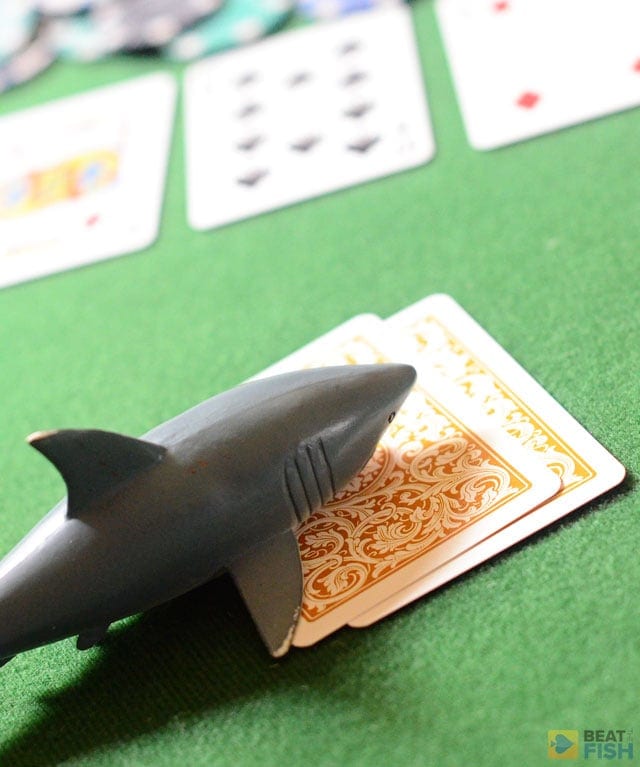
Look at these hand charts and notice the average winning percentages. Any hand that has a score over 80 is a premium hand and anything over about 65 are very strong hands.
That’s what these poker hand percentages are all about: telling you which hands to play pre-flop before you have any other information.
The numbers tell you they’re good hands because they simple win more often than others on average.
What to take away from hand strength rankings
Essentially, the lesson here is to hold strong starting cards and thin the field when you play a hand likely to be the favorite.
You can see the extremely low average winning poker hand percentages for commonly played hands like Q-10 or J-9 so my advice would have to be to stick to the premium hands as you learn the game.
As you gain more experience you can experiment with those lower percentage starting cards, but you’ll need to be disciplined enough to learn when to continue beyond the flop.
Every poker hand’s strength decreases against more players

Interestingly, but not surprisingly, every hand wins dramatically less when it is played against more opponents. Even the top two Hold’em hands of A-A and K-K win, on average, less than half of the pots when 4 or 5 players stay in.
Those community flops are a realistic scenario at looser USA-facing sites like Ignition Poker and Bovada Poker. Your goal should be to thin the field preflop and increase your odds of that premium hand holding up.
The hands that you want to encourage opponents with, such as low suited connectors, have such low winning expectations anyway that you’ll need huge pot odds from the extra callers to make them worthwhile.
These are essential Texas Hold’em concepts.
Poker hand strength fundamentals
Of course, the fundamentals of poker are based on proper starting hand selection so take a look at the above charts and see how the cards you play rank.
Before the flop even hits the board in Texas Hold’em, the two hole cards you’re dealt set the stage for your potential success. Understanding poker hand rankings, the relative strength of starting hands, and the probability of improving them is a vital skill that separates skilled players from those relying solely on luck.

The Building Blocks of Winning Hands
Here’s a quick reminder of categories to keep in mind, incorporating the full range of hand types:
- Premium Pairs: Pocket pairs, especially high pairs like Aces, Kings, or Queens, put you ahead of most opponents right off the bat.
- Suited Connectors/Suited Gappers: Suited cards in sequence (like Jack-Queen of hearts) or close to it (like 9-Jack of diamonds, known as a “one-gapper”) increase your chances of hitting straights or flushes on the board.
- High Cards: While not ideal, high-ranking cards like an Ace or King with a suitable kicker can sometimes win hands, especially in position.
- Two Pair: Two separate pairs of cards, like a pair of Queens and a pair of Tens. This can be a strong hand, but can be vulnerable to higher two pairs or trips (three of a kind).
- One Pair: Two cards of the same value, like a pair of Jacks. The strength of one pair depends on the kicker (the next highest card) and the community cards.
- Three of a Kind (Trips): Three cards of the same value (like three Sevens). This is a strong hand, but can be beaten by a full house (three of a kind and a pair) or four of a kind.
- Straight: Five cards in sequence, but not of the same suit (like 8-9-10-Jack-Queen).
- Flush: Five cards of the same suit, but not in sequence (like all hearts).
- Full House (Boat): Three cards of the same value combined with a separate pair (like three Eights and a pair of Kings). This is a very strong hand.
- Four of a Kind (Quads): Four cards of the same value (like four Sevens). This is a very powerful hand, only beaten by a straight flush or a royal flush.
- Straight Flush: Five cards in sequence, all of the same suit. This is a very strong hand, only beaten by a royal flush.
- Royal Flush: The ultimate hand – an Ace, King, Queen, Jack, and Ten of the same suit (hearts, clubs, diamonds, or spades)
Beyond Starting Hands
Of course, learning from these charts is only the beginning. There is also plenty of complexity and nuance to preflop hand selection. You should consider the following:
The Importance of Table Position
Position at the poker table greatly influences the strength of your starting hands. There are generally three categories:
- Early Position (EP): The first few positions to act after the blinds. Here, you’ll want to be more selective and favor premium hands like high pairs and suited connectors.
- Middle Position (MP): Midway through the betting order. You can start to loosen up slightly and play more speculative hands like suited one-gappers and suited two-gappers, especially if previous players have shown weakness.
- Late Position (LP): This includes the cutoff, dealer button, and blinds. You have the advantage of observing other players’ actions before making your decision, allowing you to play a wider range of hands profitably.
A hand like King-Queen suited might be a fold in early position but becomes worth playing from the button if everyone before you has folded. Even without the best hand on the flop, position might afford you the flexibility to bluff later with just a high card or single pair.
Stack Size
The size of your stack in relation to the blinds and other players will influence your preflop strategy:
- Deep Stacks: With a large stack, you can afford to play more speculative hands and potentially win larger pots with strong made hands.
- Short Stacks: When your stack is limited, you should tighten your range and focus on high-value hands that can win all-in confrontations.
With a short stack, you might only play pocket pairs or top-tier suited Aces, as these hands give you the best chance to double up or increase your stack significantly.
Mastering preflop hand strength is about more than just memorizing poker hand rankings. By understanding how starting hand charts work, the impact of position, and your stack depth relative to the blinds, you’ll make smarter, more strategic decisions that set you up for long-term poker success.
If you’re looking for more poker strategy you can check out our extensive poker strategy section or my latest mega poker guide on how to stop losing at online poker.
More Resources
- Wikipedia’s statistics about Texas Hold’em starting hands
- About’s overview on starting hand strength
- PokerDope developed an amazing poker variance calculator
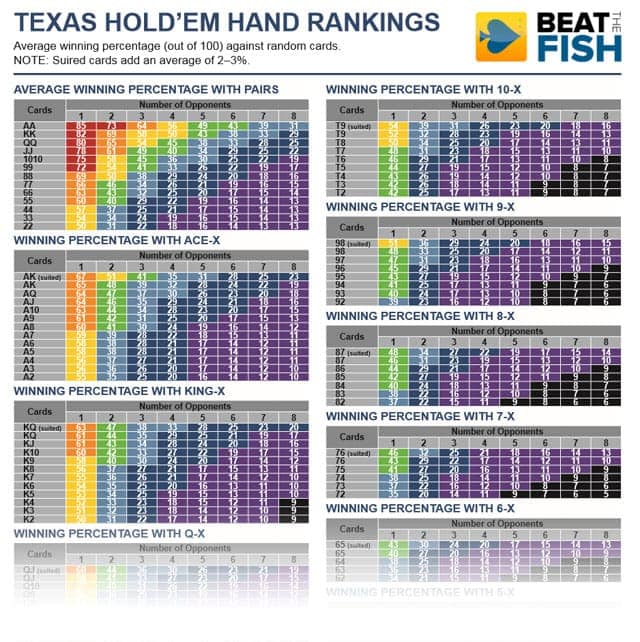




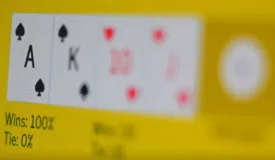





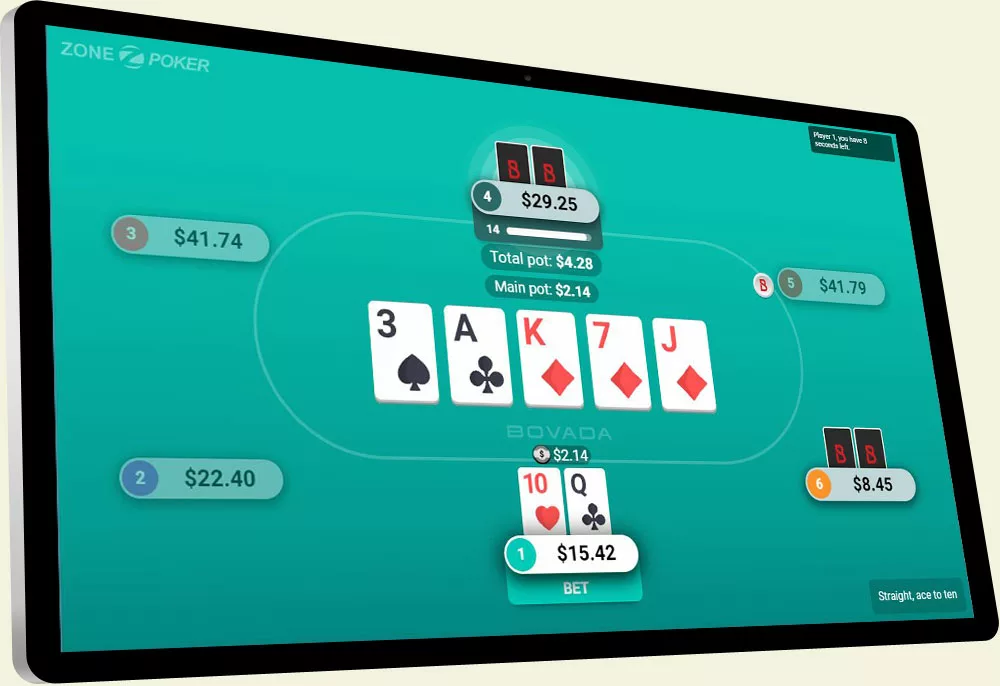
So are the hands listed like 75 listed as suited or non suited. Is it 41% or 44% vs 1 player.
Unless specified, the winning poker hand percentages listed are unsuited.
I put one suited row in each unpaired hand’s table to show an example of how much suited cards add to the average winning percentages.
Usually, it’s 3-4%, so if you see 41% listed for 7-5 offsuit it would be 44-45% for 7-5 suited.